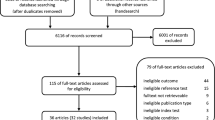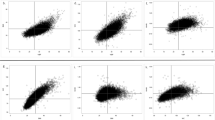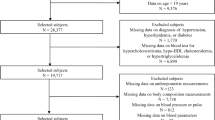Abstract
The most popular measure for conducting analyses in studies of adiposity is body mass index (BMI); however, BMI does not discriminate between muscle and adipose tissue and does not directly assess regional adiposity. In this article, we address the question of whether alternatives to BMI should be used in epidemiologic analyses of the consequences of obesity. In general, measures of fat distribution such as waist circumference and sagittal abdominal diameter are more highly correlated with cardiovascular disease risk factors and diabetes than BMI; however, differences are usually small. Precise measures of adiposity from methods such as dual-energy x-ray absorptiometry may provide more specific and larger associations with disease, but published studies show that this is not always true. Further, practical considerations such as cost and feasibility must influence the choice of measure in many studies of large populations. Measures of adiposity are highly correlated with each other, and the additional cost of a more precise measure may not be justified in many circumstances. Validated prediction equations that include multiple anthropometric measures, along with demographic variables, may offer a practical means of obtaining assessments of total adiposity in large populations, whereas waist circumference can provide a feasible assessment of abdominal adiposity. Finally, public health messages to the public must be simple to be effective. Therefore, investigators may need to consider the ease of translation of results to the public when choosing a measure.
This is a preview of subscription content, access via your institution
Access options
Subscribe to this journal
Receive 12 print issues and online access
$259.00 per year
only $21.58 per issue
Buy this article
- Purchase on Springer Link
- Instant access to full article PDF
Prices may be subject to local taxes which are calculated during checkout
Similar content being viewed by others
References
World Health Organization. Obesity: Preventing and Managing the Global Epidemic: Report of a WHO Consultation on Obesity. World Health Organization: Geneva, 1998, pp 1–276.
National Institutes of Health. National Heart Lung and Blood Institute. Clinical guidelines on the identification, evaluation, and treatment of overweight and obesity in adults—the evidence report. Obes Res 1998; 6 (Suppl 2): 51S–209S.
Stevens J, Truesdale KP . Obesity: fat distribution. In: Caballero B, Allen L, Prentice A (eds). Encyclopedia of Human Nutrition, 2nd edn. Elsevier Ltd: Oxford, 2005, pp 392–399.
Abbate LM, Stevens J, Schwartz TA, Renner JB, Helmick CG, Jordan JM . Anthropometric measures, body composition, body fat distribution, and knee osteoarthritis in women. Obesity (Silver Spring) 2006; 14: 1274–1281.
Lewis CE, Jacobs Jr DR, McCreath H, Kiefe C, Schreiner P, Smith D et al. Weight gain continues in the 1990s: 10-year trends in weight and overweight from the CARDIA study. Am J Epidemiol 2000; 151: 1172–1181.
Juhaeri, Stevens J, Jones DW, Arnett D . Associations of aging and birth cohort with body mass index in a biethnic cohort. Obes Res 2003; 11: 426–433.
Stevens J, Knapp R, Keil J, Verdugo R . Changes in body weight and girths in black and white adults studied over a 25-year interval. Int J Obes 1991; 15: 803–808.
Shimokata H, Muller D, Andres R . Studies in the distribution of body fat. III. Effects of cigarette smoking. JAMA 1989; 261: 1169–1173.
Lohman TG . Skinfolds and body density and their relation to body fatness: a review. Hum Biol 1981; 53: 181–225.
Shimokata H, Andres R, Coon PJ, Elahi D, Muller DC, Tobin JD . Studies in the distribution of body fat. II. Longitudinal effects of change in weight. Int J Obes 1989; 13: 455–464.
Stevens J, Plankey M, Keil J, Rust P, Tyroler H, Davis C . Black women have smaller abdominal girths than white women of the same relative weight. J Clin Epidemiol 1994; 47: 495–499.
Hoffman DJ, Wang Z, Gallagher D, Heymsfield SB . Comparison of visceral adipose tissue mass in adult African Americans and whites. Obes Res 2005; 13: 66–74.
Despres JP, Couillard C, Gagnon J, Bergeron J, Leon AS, Rao DC et al. Race, visceral adipose tissue, plasma lipids, and lipoprotein lipase activity in men and women: the Health, Risk Factors, Exercise Training, and Genetics (HERITAGE) family study. Arterioscler Thromb Vasc Biol 2000; 20: 1932–1938.
Hill JO, Sidney S, Lewis CE, Tolan K, Scherzinger AL, Stamm ER . Racial differences in amounts of visceral adipose tissue in young adults: the CARDIA (Coronary Artery Risk Development in Young Adults) study. Am J Clin Nutr 1999; 69: 381–387.
Albu JB, Murphy L, Frager DH, Johnson JA, Pi-Sunyer FX . Visceral fat and race-dependent health risks in obese nondiabetic premenopausal women. Diabetes 1997; 46: 456–462.
Deurenberg P, Yap M, van Staveren WA . Body mass index and percent body fat: a meta analysis among different ethnic groups. Int J Obes Relat Metab Disord 1998; 22: 1164–1171.
Deurenberg P, Deurenberg-Yap M, Guricci S . Asians are different from Caucasians and from each other in their body mass index/body fat percent relationship. Obes Rev 2002; 3: 141–146.
Forouhi NG, Jenkinson G, Thomas EL, Mullick S, Mierisova S, Bhonsle U et al. Relation of triglyceride stores in skeletal muscle cells to central obesity and insulin sensitivity in European and South Asian men. Diabetologia 1999; 42: 932–935.
Park YW, Allison DB, Heymsfield SB, Gallagher D . Larger amounts of visceral adipose tissue in Asian Americans. Obes Res 2001; 9: 381–387.
Raji A, Seely EW, Arky RA, Simonson DC . Body fat distribution and insulin resistance in healthy Asian Indians and Caucasians. J Clin Endocrinol Metab 2001; 86: 5366–5371.
Zhu S, Heymsfield SB, Toyoshima H, Wang Z, Pietrobelli A, Heshka S . Race-ethnicity-specific waist circumference cutoffs for identifying cardiovascular disease risk factors. Am J Clin Nutr 2005; 81: 409–415.
Festa A, D'Agostino Jr R, Williams K, Karter AJ, Mayer-Davis EJ, Tracy RP et al. The relation of body fat mass and distribution to markers of chronic inflammation. Int J Obes Relat Metab Disord 2001; 25: 1407–1415.
Janssen I, Katzmarzyk PT, Ross R . Waist circumference and not body mass index explains obesity-related health risk. Am J Clin Nutr 2004; 79: 379–384.
Zamboni M, Armellini F, Sheiban I, De Marchi M, Todesco T, Bergamo-Andreis I et al. Relation of body fat distribution in men and degree of coronary narrowings in coronary artery disease. Am J Cardiol 1992; 70: 1135–1138.
Iribarren C, Darbinian JA, Lo JC, Fireman BH, Go AS . Value of the sagittal abdominal diameter in coronary heart disease risk assessment: cohort study in a large, multiethnic population. Am J Epidemiol 2006; 164: 1150–1159.
Ohrvall M, Berglund L, Vessby B . Sagittal abdominal diameter compared with other anthropometric measurements in relation to cardiovascular risk. Int J Obes Relat Metab Disord 2000; 24: 497–501.
Hwu CM, Hsiao CF, Sheu WH, Pei D, Tai TY, Quertermous T et al. Sagittal abdominal diameter is associated with insulin sensitivity in Chinese hypertensive patients and their siblings. J Hum Hypertens 2003; 17: 193–198.
Schoen RE, Thaete FL, Sankey SS, Weissfeld JL, Kuller LH . Sagittal diameter in comparison with single slice CT as a predictor of total visceral adipose tissue volume. Int J Obes Relat Metab Disord 1998; 22: 338–342.
Sierra-Johnson J, Johnson BD, Bailey KR, Turner ST . Relationships between insulin sensitivity and measures of body fat in asymptomatic men and women. Obes Res 2004; 12: 2070–2077.
Stevens J, Couper D, Pankow J, Folsom A, Duncan B, Nieto F et al. Sensitivity and specificity of anthropometrics for the prediction of diabetes in a biracial cohort. Obes Res 2001; 9: 696–705.
Heitmann BL, Erikson H, Ellsinger BM, Mikkelsen KL, Larsson B . Mortality associated with body fat, fat-free mass and body mass index among 60-year-old Swedish men—a 22-year follow-up. The study of men born in 1913. Int J Obes Relat Metab Disord 2000; 24: 33–37.
Allison DB, Faith MS, Heo M, Kotler DP . Hypothesis concerning the U-shaped relation between body mass index and mortality. Am J Epidemiol 1997; 146: 339–349.
Lohman TG, Caballero B, Himes JH, Davis C, Stewart D, Houtkooper L et al. Estimation of body fat from anthropometry and bioelectrical impedance in Native American children. Int J Obes Relat Metab Disord 2000; 24: 982–988.
Deurenberg P, van der Kooy K, Leenen R, Weststrate JA, Seidell JC . Sex and age specific prediction formulas for estimating body composition from bioelectrical impedance: a cross-validation study. Int J Obes 1991; 15: 17–25.
Loftin M, Nichols J, Going S, Sothern M, Schmitz KH, Ring K et al. Comparison of the validity of anthropometric and bioelectric impedance equations to assess body composition in adolescent girls. Int J of Body Comp Res 2007; 5: 1–8.
Deurenberg P, Deurenberg-Yap M . Validity of body composition methods across ethnic population groups. Acta Diabetol 2003; 40 (Suppl 1): S246–S249.
Author information
Authors and Affiliations
Corresponding author
Rights and permissions
About this article
Cite this article
Stevens, J., McClain, J. & Truesdale, K. Selection of measures in epidemiologic studies of the consequences of obesity. Int J Obes 32 (Suppl 3), S60–S66 (2008). https://doi.org/10.1038/ijo.2008.88
Published:
Issue Date:
DOI: https://doi.org/10.1038/ijo.2008.88
Keywords
This article is cited by
-
Relationship between cognitive function and weight-adjusted waist index in people ≥ 60 years old in NHANES 2011–2014
Aging Clinical and Experimental Research (2024)
-
The moderating role of eating behaviour traits in the association between exposure to hot food takeaway outlets and body fatness
International Journal of Obesity (2023)
-
Determining the joint effect of obesity and diabetes on functional disability at 3-months and on all-cause mortality at 1-year following an ischemic stroke
BMC Endocrine Disorders (2018)
-
Obesity and depressive symptoms in mid-life: a population-based cohort study
BMC Psychiatry (2018)
-
Association between PPAR-γ2 Pro12Ala polymorphism and obesity: a meta-analysis
Molecular Biology Reports (2015)



